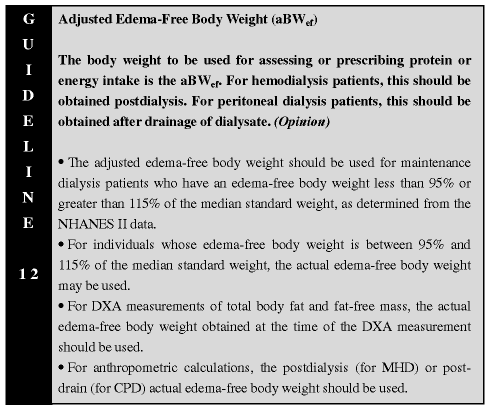
1. Evaluation of Protein-Energy Nutritional Status

The wide range in body weight and body composition observed among dialysis patients seriously limits the use of the actual body weight for assessment or prescription of nutritional intake. The use of the actual or unadjusted body weight to assess the actual nutrient intake or to prescribe the intake of energy and protein can be hazardous when individuals are very obese or very underweight. On the other hand, it may be hazardous to ignore the effects of the patient's body size on dietary needs and tolerance in individuals who are markedly underweight or overweight. It is recognized that the determination of the patient's edema-free body weight is often difficult and not precise. Clinical judgement based on physical examination and, if necessary, body composition measurements are used to estimate the presence or absence of edema.
The following equation can be used to calculate the edema-free adjusted body weight (aBWef)63:

where BWef is the actual edema-free body weight and SBW is the standard body weight as determined from the NHANES II data.89 Since interdialytic weight gain (IDWG) can be as high as 6 to 7 kg in HD patients, and peritoneal dialysate plus intraperitoneal ultrafiltrate can reach 2 to 5 kg, the aBWef should be calculated based on postdialysis values for HD patients and post-dialysate drain measurements for peritoneal dialysis patients.
Equation 1 takes into account the fact that the metabolic needs and dietary protein and energy requirements of adipose tissue in obese individuals is less than that of edema-free lean body mass and also that very underweight individuals are less likely to become metabolically overloaded if they are prescribed diets based on their aBWef as compared with the standard (normal) body weight for individuals of similar age, height, gender, and skeletal frame size. Since the volume of distribution of urea and other protein metabolites is reduced in smaller individuals, a reduced protein prescription based on the aBWef, as compared with the standard weight, should lead to a lesser rate of accumulation of these metabolites in the body. On the other hand, use of the aBWef instead of the actual body weight of an underweight individual may provide the additional nutrients necessary for nutrient repletion. The use of the aBWef for prescribing protein or energy intake should be considered as a starting point. As always, clinical judgment and longitudinal assessment of body weight and other nutritional measures should be used to assess the response to dietary therapy and for making further decisions concerning dietary management.
The use of the aBWef may not be required for all patients. Clinical experience suggests that the actual edema-free body weight may be used effectively for nutritional assessment and nutritional prescription when the BWef is between 95% and 115% of the SBW as determined from the median body weights obtained from the NHANES II data.89